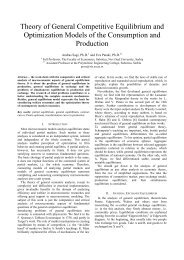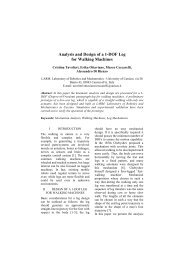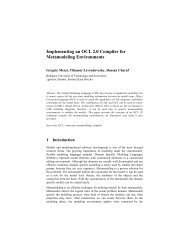Artificial Intelligence and Machine Learning
Artificial Intelligence and Machine Learning
Artificial Intelligence and Machine Learning
You also want an ePaper? Increase the reach of your titles
YUMPU automatically turns print PDFs into web optimized ePapers that Google loves.
effects can be obtained with reinforcement learning. Reinforcement learning<br />
incorporates feedback from the results of action. In reinforcement learning, the<br />
learning gain factor g(t) varies with time such that it conveys information as to<br />
whether the evaluation computed by the value judgment module was good<br />
(rewarding), or bad (punishing). Reward reinforcement learning in the behavior<br />
generation system is a form of positive feedback. Punishing reinforcement, or<br />
error correcting, learning occurs when g(t) is negative, i.e., punishing.<br />
Error correction learning is a form of negative feedback. With each training<br />
experience, the amount of error is reduced, <strong>and</strong> hence the amount of punishment.<br />
Error correction is therefore self limiting <strong>and</strong> tends to converge toward a stable<br />
results.<br />
In specific error correction, sometimes called teacher learning, not only is the<br />
overall behavioral result g(t) known, but the correct or desired response of each<br />
output neuron is provided by a teacher. Thus the precise error for each neuron is<br />
known.<br />
Teacher learning tends to converge rapidly to stable precise results. Teacher<br />
learning is always error correcting. The teacher provides the correct response, <strong>and</strong><br />
anything different is an error. Therefore, g(t) must always be negative to correct<br />
the error.<br />
Teacher learning may also be used for task skill learning in cases where a high<br />
level behavior generation module can act as a teacher to a lower level behavior<br />
generation module, i.e., by providing desired output responses to specific<br />
comm<strong>and</strong> <strong>and</strong> feedback inputs.<br />
4 Computer-Assisted Instruction Systems<br />
Computer–assisted instruction has been in use for many years, bringing the power<br />
of the computer to bear on the educational process.<br />
Early CAI programs essentially imitated previously existing instructional<br />
materials. For example, a common CAI technique mirrors a method called<br />
programmed instruction. In a programmed instruction text, students read brief<br />
instructional material <strong>and</strong> then are presented with short questions to test their<br />
comprehension. Students turn to different pages of the book, depending on their<br />
answers to the questions, so that each student effectively "programs" a different<br />
path through the material based on individual comprehension abilities.<br />
The CAI technique based on programmed instruction is known as frame-based<br />
CAI. In frame-based CAI, a student responds to problems presented by computer.<br />
The computer is programmed to react differently to possible student responses. If












